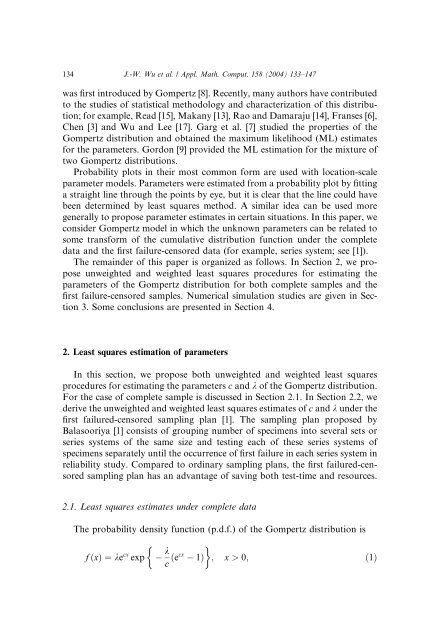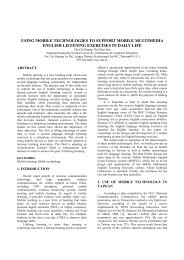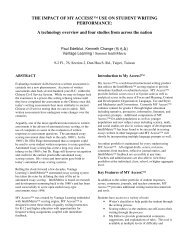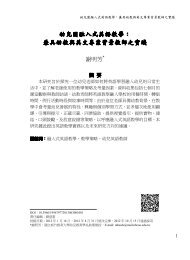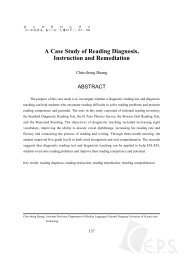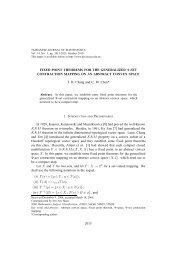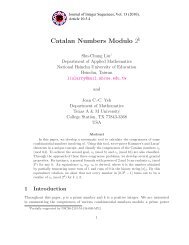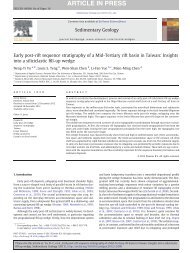Estimation of parameters of the Gompertz distribution using the least ...
Estimation of parameters of the Gompertz distribution using the least ...
Estimation of parameters of the Gompertz distribution using the least ...
You also want an ePaper? Increase the reach of your titles
YUMPU automatically turns print PDFs into web optimized ePapers that Google loves.
134 J.-W. Wu et al. / Appl. Math. Comput. 158 (2004) 133–147<br />
was first introduced by <strong>Gompertz</strong> [8]. Recently, many authors have contributed<br />
to <strong>the</strong> studies <strong>of</strong> statistical methodology and characterization <strong>of</strong> this <strong>distribution</strong>;<br />
for example, Read [15], Makany [13], Rao and Damaraju [14], Franses [6],<br />
Chen [3] and Wu and Lee [17]. Garg et al. [7] studied <strong>the</strong> properties <strong>of</strong> <strong>the</strong><br />
<strong>Gompertz</strong> <strong>distribution</strong> and obtained <strong>the</strong> maximum likelihood (ML) estimates<br />
for <strong>the</strong> <strong>parameters</strong>. Gordon [9] provided <strong>the</strong> ML estimation for <strong>the</strong> mixture <strong>of</strong><br />
two <strong>Gompertz</strong> <strong>distribution</strong>s.<br />
Probability plots in <strong>the</strong>ir most common form are used with location-scale<br />
parameter models. Parameters were estimated from a probability plot by fitting<br />
a straight line through <strong>the</strong> points by eye, but it is clear that <strong>the</strong> line could have<br />
been determined by <strong>least</strong> squares method. A similar idea can be used more<br />
generally to propose parameter estimates in certain situations. In this paper, we<br />
consider <strong>Gompertz</strong> model in which <strong>the</strong> unknown <strong>parameters</strong> can be related to<br />
some transform <strong>of</strong> <strong>the</strong> cumulative <strong>distribution</strong> function under <strong>the</strong> complete<br />
data and <strong>the</strong> first failure-censored data (for example, series system; see [1]).<br />
The remainder <strong>of</strong> this paper is organized as follows. In Section 2, we propose<br />
unweighted and weighted <strong>least</strong> squares procedures for estimating <strong>the</strong><br />
<strong>parameters</strong> <strong>of</strong> <strong>the</strong> <strong>Gompertz</strong> <strong>distribution</strong> for both complete samples and <strong>the</strong><br />
first failure-censored samples. Numerical simulation studies are given in Section<br />
3. Some conclusions are presented in Section 4.<br />
2. Least squares estimation <strong>of</strong> <strong>parameters</strong><br />
In this section, we propose both unweighted and weighted <strong>least</strong> squares<br />
procedures for estimating <strong>the</strong> <strong>parameters</strong> c and k <strong>of</strong> <strong>the</strong> <strong>Gompertz</strong> <strong>distribution</strong>.<br />
For <strong>the</strong> case <strong>of</strong> complete sample is discussed in Section 2.1. In Section 2.2, we<br />
derive <strong>the</strong> unweighted and weighted <strong>least</strong> squares estimates <strong>of</strong> c and k under <strong>the</strong><br />
first failured-censored sampling plan [1]. The sampling plan proposed by<br />
Balasooriya [1] consists <strong>of</strong> grouping number <strong>of</strong> specimens into several sets or<br />
series systems <strong>of</strong> <strong>the</strong> same size and testing each <strong>of</strong> <strong>the</strong>se series systems <strong>of</strong><br />
specimens separately until <strong>the</strong> occurrence <strong>of</strong> first failure in each series system in<br />
reliability study. Compared to ordinary sampling plans, <strong>the</strong> first failured-censored<br />
sampling plan has an advantage <strong>of</strong> saving both test-time and resources.<br />
2.1. Least squares estimates under complete data<br />
The probability density function (p.d.f.) <strong>of</strong> <strong>the</strong> <strong>Gompertz</strong> <strong>distribution</strong> is<br />
k<br />
f ðxÞ ¼ke cx exp<br />
c ðecx 1Þ ; x > 0; ð1Þ


